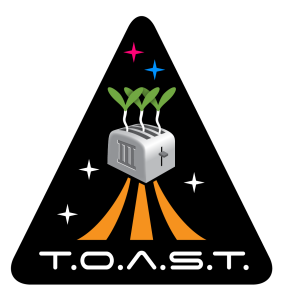Our BRIC-19 space-flown seedlings and the corresponding Earth-grown seedlings arrived back to our lab in Madison Wisconsin safe and sound. Their trip back from the Space Station began when the astronauts removed our samples from the freezer on the ISS and packed them into a cold bag, which was then placed into SpaceX’s Dragon capsule along with many other research items from the space station. The Dragon and its precious payload left the space station and after re-entry made its splashdown in the Pacific where a barge retrieved the capsule.

Splashdown of the CRS-4 Dragon capsule holding our BRIC-19 experiment. Photo by SpaceX.
After unpacking in Houston, our BRIC-19 samples made their way back to Kennedy Space Center (KSC) by truck. Then, I met the NASA team at KSC to unpack our science from the BRIC space hardware; this was the moment of truth! We carefully opened the petri dish holders and had a first look at our space-grown plants and the ground-grown controls. We were thrilled to see that every one of the 40 petri plates in our experiment had excellent growth and no contamination. Fantastic!

Sarah and the NASA team at Kennedy Space Center unpack samples from space hardware. Photo by Sandy Swanson.
We couldn’t have been happier with the results so far, but now back in the Gilroy Lab in UW-Madison critical work begins analyzing the shape and size of each BRIC-19 plant in addition to assessing the differences in gene expression.

Botany professor Simon Gilroy (left) and postdoc Won-Gyu Choi unwrap forty petri plates of plants packed in dry ice. Photo by D. Tanenbaum, UW-Madison.
Gilroy Lab postdoc Won-Gyu Choi will meticulously isolate the RNA from the seedlings in each petri plate, test its quality, and then the biotech center on campus will run an analysis called RNA seq. From this we will get the raw data about gene expression; this snapshot will allow comparison of how wild type plants regulate their growth in microgravity compared to seedlings which have a gene involved in plant mechanical responses that is always on or always off. Likewise, the GeneLab portion of BRIC-19 will allow comparison of the gene expression of a number of varieties (ecotypes) of Arabidopsis so that we can discover if one type of plant is more suited for growth in microgravity.
The were a number of news reports published when our seedlings were returned. It was great fun talking to the press about our work, the reporters did a great job communicating the details of our space biology research! Check out these published write-ups:
UW team’s plants return to Earth after growing in space (University Communications)
Out of this world: Fitchburg researchers send plants to space (Fitchburg Star)
UW researchers team up with NASA to investigate plants sent to space (Badger Herald)
UW-Madison botany researchers explore plant growth in space (Daily Cardinal)
Plants return to Earth after growing in space (Science Daily)

Sarah Swanson and Simon Gilroy at Kennedy Space Center. Photo by NASA.





















